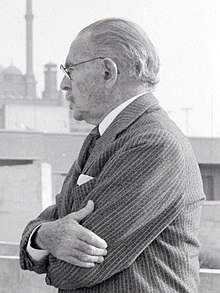The culture of Egypt has thousands of years of recorded history. Ancient Egypt was among the earliest civilizations in the world. For millennia, Egypt developed strikingly unique, complex and stable cultures that influenced other cultures of Europe, Africa and the Middle East.

The Aga Khan Award for Architecture (AKAA) is an architectural prize established by Aga Khan IV in 1977. It aims to identify and reward architectural concepts that successfully address the needs and aspirations of Muslim societies in the fields of contemporary design, social housing, community development and improvement, restoration, reuse and area conservation, as well as landscape design and improvement of the environment.

Vernacular architecture is building done outside any academic tradition, and without professional guidance. It is not a particular architectural movement or style, but rather a broad category, encompassing a wide range and variety of building types, with differing methods of construction, from around the world, both historical and extant and classical and modern. Vernacular architecture constitutes 95% of the world's built environment, as estimated in 1995 by Amos Rapoport, as measured against the small percentage of new buildings every year designed by architects and built by engineers.

A mashrabiya or mashrabiyya is an architectural element which is characteristic of traditional architecture in the Islamic world and beyond. It is a type of projecting oriel window enclosed with carved wood latticework located on the upper floors of a building, sometimes enhanced with stained glass. It was traditionally used to catch wind and for passive cooling. Jars and basins of water could be placed in it to cause evaporative cooling. It is most commonly used on the street side of the building; however, it may also be used internally on the sahn (courtyard) side. The term mashrabiya is sometimes used of similar lattices elsewhere, for instance in a takhtabush. It is similar to Indian jali.
Abdel-Wahed El-Wakil is an Egyptian architect who designed over 15 mosques in Saudi Arabia and is considered by many as the foremost contemporary authority in Islamic architecture. For designing in traditional styles, he is also a representative of New Classical Architecture.
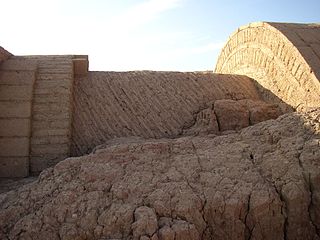
In architecture, a Nubian vault is a type of curved surface forming a vaulted structure. The mudbrick structure was revived by Egyptian architect Hassan Fathy after re-discovering the technique in the Nubian village of Abu al-Riche. The technology is advocated by environmentalists as environmentally friendly and sustainable since it makes use of pure earth without the need of timber. The technology is of Nubian origin.

There have been many architectural styles used in Egyptian buildings over the centuries, including Ancient Egyptian architecture, Greco-Roman architecture, Islamic architecture, and modern architecture.

Kurna is a group of three closely related villages located on the West Bank of the River Nile opposite the modern city of Luxor in Egypt near the Theban Hills.

The Muhammad Ali Mosque or Mosque of Muhammad Ali is a historic mosque in Cairo, Egypt. It was commissioned by Muhammad Ali Pasha and built between 1832 and 1857. Situated in the Cairo Citadel in a position overlooking the city, it is one of the most visible mosques and landmarks in the skyline of Cairo. Unlike the traditional Cairene architecture that preceded it, the mosque was built in an entirely Ottoman and European-influenced style, further setting it apart from other monuments. It is sometimes called the Alabaster Mosque due to the prominent use of alabaster as a covering for its walls.
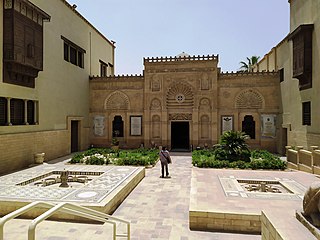
Coptic architecture is the architecture of the Coptic Christians, who form the majority of Christians in Egypt.

Abdullah Nooruddeen Durkee was a Muslim scholar, thinker, author, translator, and the Khalifah (successor) for North America of the Shadhdhuli School for Tranquility of Being and the Illumination of Hearts, Green Mountain Branch. Nooruddeen Durkee became a Muslim in his early thirties in Al-Quds, Jerusalem. He was one of the co-founders of Lama Foundation and founder of Dar al-Islam Foundation.
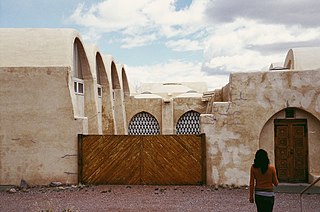
Dar al-Islam is a Muslim educational center located near Abiquiú, New Mexico, US.
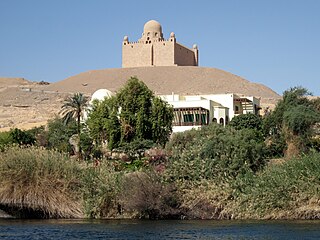
The Mausoleum of Aga Khan is the mausoleum of Aga Khan III, Sir Sultan Muhammed Shah, who died in 1957. The mausoleum is located at Aswan along the Nile of Egypt, since Egypt was formerly the centre of power of the Fatimids, an Ismaili Shia dynasty.
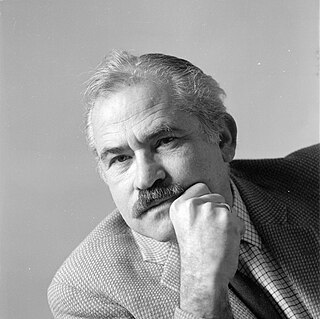
Dimitri Papadimos was a Greek photographer.
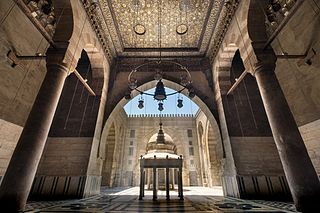
Mosque-Madrasa of Sultan Barquq or Mosque-Madrasa-Khanqah of Az-Zaher Barquq is a religious complex in Islamic Cairo, the historic medieval district of Cairo, Egypt. It was commissioned by Sultan al-Zahir Barquq as a school for religious education in the four Islamic schools of thought, composed of a mosque, madrasa, mausoleum and khanqah. The complex was constructed in 1384-1386 CE, with the dome added last. It was the first architectural facility built during the rule of the Circassian (Burji) dynasty of Mamluk Sultanate.

The architecture of Casablanca is diverse and historically significant. Casablanca, Morocco's economic capital, has a rich urban history and is home to many notable buildings in a variety of styles. Throughout the 20th century, architecture and urban development in Casablanca evolved in a way that was simultaneously specific to the city's contexts, and consonant with international ideas.

Salma Samar Damluji is a Lebanon-born architect, professor and author based between London and the Middle East. She worked with the Egyptian architect Hassan Fathy in Cairo, in 1975-6 and in 1984–5. She was appointed architectural advisor to the UAE minister Shaykh Sultan bin Zayed Al Nahyan in 2001–2004 on the Sheikh Zayed Grand Mosque and other projects in Abu Dhabi. In 2008, she established the Daw'an Mud Brick Architecture Foundation in Hadramaut, with colleagues in Yemen and has been working there on earth construction and rehabilitation projects.

Mario Rossi (1897-1961) was an Italian architect and notable contributor to 20th-century Islamic architecture.
Mahmoud Riad was a prolific Egyptian architect, urban planner, and housing policy maker. Over a four decade career, Riad designed and built many iconic buildings in New York, Cairo, Alexandria and Kuwait, and is considered a "foundational figure in twentieth century Egyptian architecture," and one of the 'pioneer' Egyptian architects. He held government positions in architecture and planning departments, and founded the Egyptian government's first high office for housing, the Department of Popular Homes.
